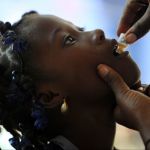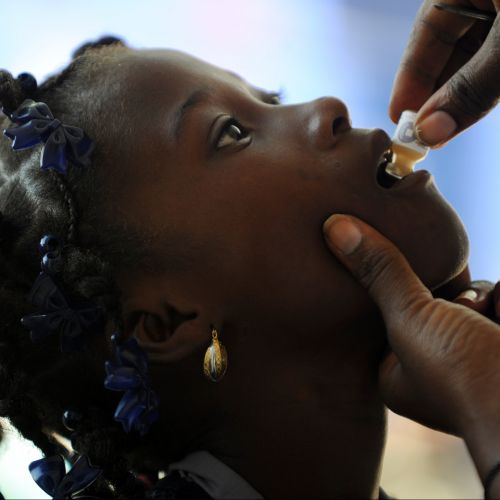
The clinics were overwhelmed. Over just a few days in 2010, cholera had swept through the chaos of earthquake-ravaged Haiti. Violently ill patients were packing wards, slumping in tents, and dying within hours of showing their first symptoms.
Dr. Louise Ivers, an infectious disease specialist, needed help. She and other medical professionals were working without sleep, besieged by a stream of weak patients struggling into the clinics.
There was a vaccine available. Although the cache was not nearly large enough — and still not fully approved by the World Health Organization — Ivers and others appealed to Haitian officials to allow them to distribute the drug.
The government said no.
“This was a missed opportunity to save lives,” Ivers, who ran a clinic in Haiti for the nonprofit Partners in Health, recalled in a recent interview.
Today, the epidemic is seen as a pivotal moment in a dispute over the best way to counter cholera. On one side are public health advocates, backed by the powerful Bill and Melinda Gates Foundation, who have been galvanized in their enthusiasm for vaccines. Those vaccines, they believe, can be used to make major strides against a disease that is thousands of years old, easily treated, and entirely preventable.
On the other are public health officials who argue that the vaccines are not effective enough and are a Band-Aid diverting attention from the water and sanitation issues that are at the root of cholera.
“This is a disease of poverty,” said Shafiqul Islam, director of the Water Diplomacy Program at Tufts University. “There is a group of people who think vaccines will solve the problem. I don’t think it will.”
Experts on both sides acknowledge the disagreement has undermined unity in the fight against cholera. The WHO has tried to straddle the divide by supporting both approaches, without settling how to pay for both.
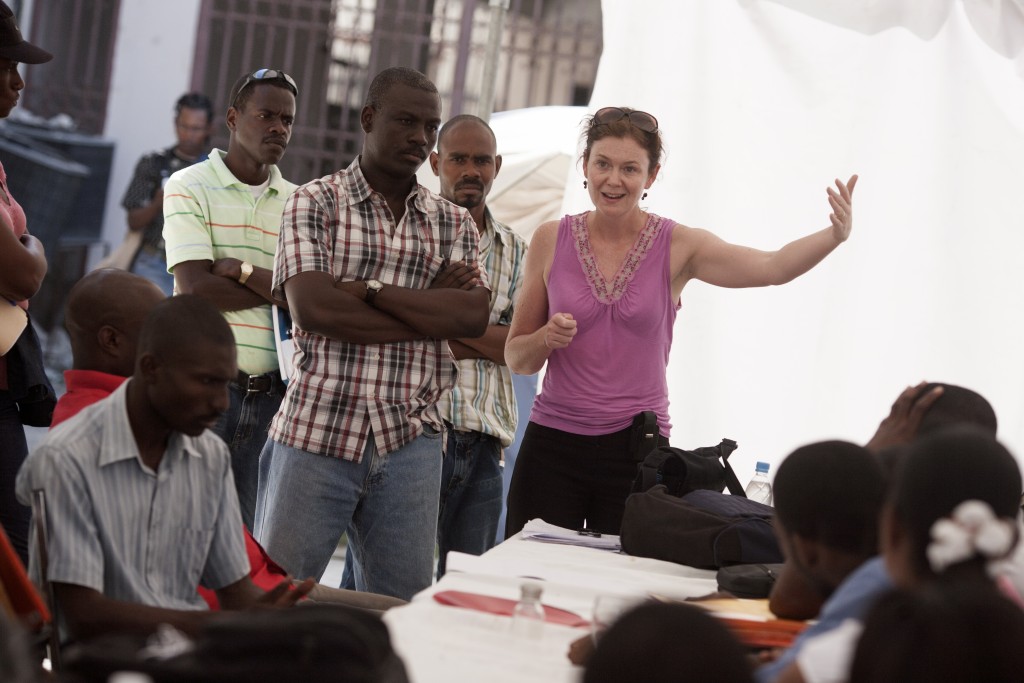
JUSTIN IDE/HARVARD UNIVERSITY
Dr. Louise Ivers leads a training in Port-Au-Prince in February 2010.
Caused by bacteria, cholera is spread through contaminated water, and it kills by massively dehydrating victims’ bodies through diarrhea and vomiting.
The WHO says about 100,000 people die worldwide from cholera each year. It is a rough estimate: Some countries do not report cases, and victims often die in isolated rural communities, the cause of their deaths unrecorded.
The disease roars seasonally into India, Bangladesh, and the Democratic Republic of Congo, and made appearances last year in 32 countries. Outbreaks typically center on Africa, South Asia, and, recently, the Middle East.
There are year-to-year fluctuations in the number of cholera cases, but the overall incidence does not seem to be dropping.
Two oral vaccines exist, and the most useful, called Shanchol, was available in limited supplies when the epidemic began in Haiti. It had been administered widely in Vietnam since 1997, but at the time of the Haitian crisis — which came as a handmaiden of death after the country’s earthquake and ultimately killed 9,000 people — the WHO was awaiting the results of a larger study and had not signed off on international distribution.
Since then, the WHO has approved the vaccine and the Gates Foundation — the source of major public health funding — has weighed in forcefully to promote its use. Among other steps, the foundation has pumped about $20 million into Shanchol and helped jumpstart manufacturing of the vaccine in India.
As of mid-2013, public health officials had at their disposal a stockpile of 2 million doses that can be moved quickly to an area of need. The vaccine was used successfully in rural Guinea in 2012 and again in refugee camps in South Sudan in 2013. Some 500,000 doses have been sent to Iraq, where continuing violence has helped fuel the emergence of more than 2,000 cholera cases.
Helen Matzger, senior program officer at the Gates Foundation, said the decision to promote the vaccine made sense.
“When you look at the amount of money it would take to make infrastructure improvements, that’s well outside what a foundation could do,” she said.
But the vaccine has drawbacks: It must be administered in two doses, two weeks apart, a daunting task in an emergency. And it is far from perfect clinically — it cuts a person’s risk of contracting the disease by an average of 50 percent to 65 percent over two years. After that, a recipient’s immunity drops even further.
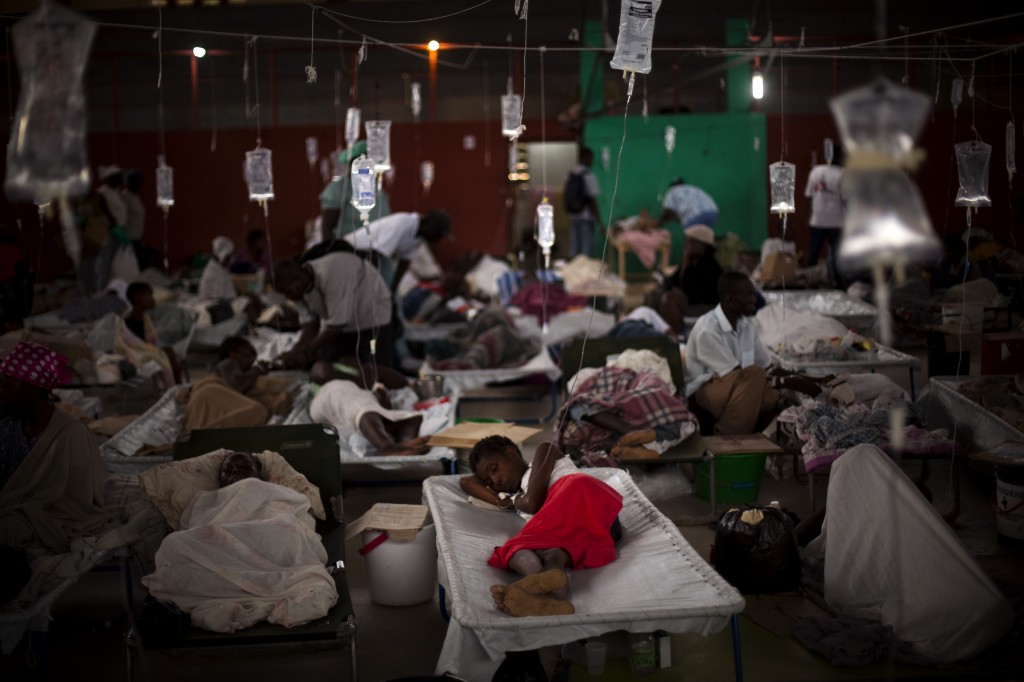
EMILIO MORENATTI/AP
People suffering cholera symptoms are treated in a sports center converted into a cholera treatment center in Cap-Haitien, Haiti, in 2010.
More to the point, critics noted, reliance on a vaccine does not address the underlying causes of cholera.
“You are really only going to solve this with an investment and infrastructure and maintenance of the infrastructure,” said David Olson, deputy medical director of Doctors Without Borders. He advocates a focus on assisting the 900 million people worldwide without clean water and the 2.5 billion people without good sanitation.
Ivers, now senior health and policy adviser for Partners in Health, does not dispute the importance of that goal.
“Nobody is saying [a vaccine] replaces water and sanitation,” said Ivers. “But there are still those who say spending $1 million on vaccines is $1 million we don’t have to spend on water and sewer.”
Read more: A radically simple idea may open the door to a new world of antibiotics
Cholera has likely been around as long as man. As societies became urbanized, epidemics were swift, massive, and deadly. More than 14,000 died in London in an 1849 outbreak. Thousands more died when cholera reached New York that year. President James Polk was a victim.
The breakthrough against this disease is medical legend. Dr. John Snow, a London physician, rejected the belief that the disease was spread by “bad air,” and began meticulously plotting cholera deaths on a map of Soho in 1854. His plots revealed a key crossroads around a water pump on Broad Street. He got the pump handle removed, stopped the epidemic, and proved contaminated water is the source of the disease.
“It has always inspired fear because it is so sudden and horrifying,” said Eric Mintz, a cholera expert at the CDC. “We really have made significant progress in understanding how cholera spreads, evolves, how it can be prevented and how it can be treated.”
Though naturally present in tropical, brackish waters, cholera may surge into an epidemic when human waste from a sick person contaminates water used by others for drinking, bathing, or growing crops.
Without treatment, cholera can drain victims’ bodies of so much fluid in just six hours that their bodies can no longer pump blood. Death follows immediately. Children can succumb even faster.
The separation of sanitation and water systems in cities following Snow’s revelation have largely eliminated cholera in developed countries. And doctors have learned how to effectively treat it.
Quick infusion of large quantities of a simple saline solution of water, salt, and sugar — either by drinking or through an IV infusion — works. Such a solution can convert a deadly bout of cholera into an illness from which patients can recover quickly.
In countries where cholera is endemic, a regular occurrence, people know to act fast.
“I’ve had it several times,” said Maimuna Majumder, an engineer who works regularly in Bangladesh. “Everybody gets it every year. Everybody knows what it is.”
But the deadliest outbreaks occur unexpectedly. Haiti was never known to have cholera, despite its poor water and sewer infrastructure.
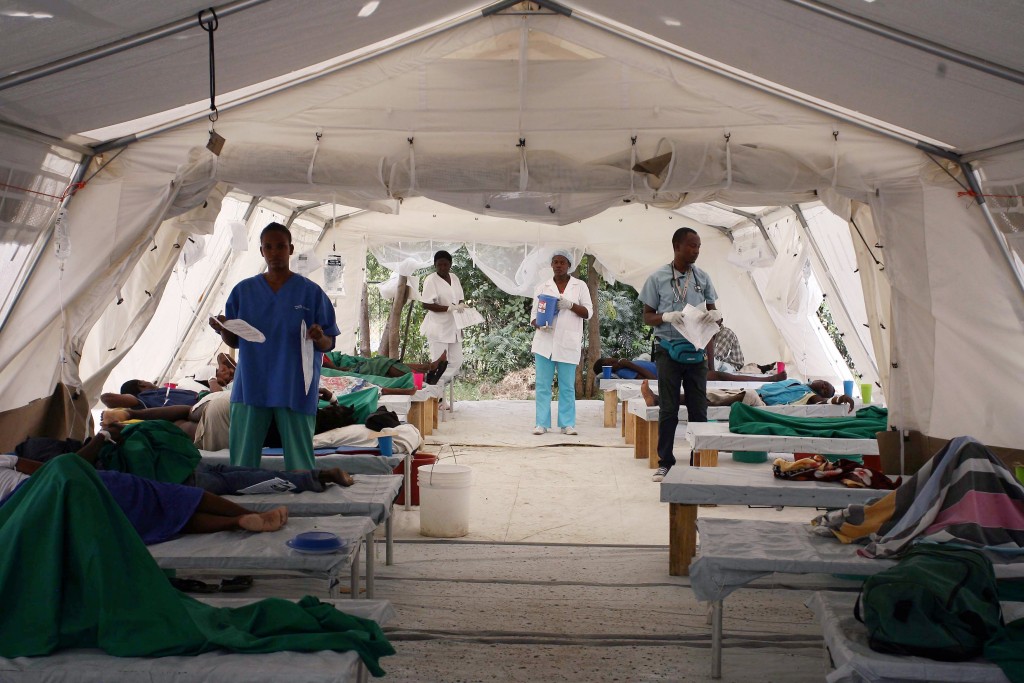
HECTOR RETAMAL/AFP/GETTY IMAGES
Medical personnel tend to patients suffering from cholera at the Hospital Bicentenaire run by Doctors Without Borders in Port-au-Prince in 2010.
After the earthquake, however, a United Nations peacekeeper likely brought the bacteria from Nepal, a UN investigation found. Latrine runoff from a UN camp apparently reached a major river used for drinking and washing, and the epidemic erupted within days.
Ivers recalled being at a meeting and getting a message from a colleague that 100 patients had arrived overnight at a rural clinic with severe diarrhea.
“We were all afraid to say the word,” she recalled. “Everybody was taking a deep breath, saying, ‘Oh, please, no.’”
Because cholera was unknown in Haiti, people did not recognize it and doctors were not used to treating it. Oral saline solutions and IVs were not there in the numbers needed. The sick crowded wards or slept in tents tended by family members, with few controls to stop further infection.
“It was chaotic and fearful,” said Daniele Lantagne, who was on the UN team sent to investigate the outbreak, and is now on the faculty at Tufts University. “Haiti had absolutely no idea what it was. They literally thought it was voodoo, the curse of god.”
Read more: How a system meant to develop drugs for rare diseases broke down
Ivers and Paul Farmer, co-founder of Partners in Health, urged the government to improve sanitation and to buy the 200,000 available doses of Shanchol — enough for 100,000 people — and rush it into use. But the government rejected the appeal.
“There’s a lot of criticism about the decision,” said Olson, of Doctors Without Borders, who was on the ground in Haiti soon after the outbreak. “But at the time, if you had to figure out who are you going to give 100,000 doses to out of 10 million people, how do you do that?”
“The vaccine would not have prevented the exponential spread of the disease,” said Lantagne. “It could have blunted the curve, yes, but it would not have prevented the epidemic.”
Ivers, who finally got approval to administer the vaccine to 45,000 Haitians as the epidemic stretched into its second year, said the results of her experiment — a 65 percent reduction in cases — proved the vaccine’s worth.
“Even if they only had 200,000 doses in the bank, we could’ve bought those and got started,” Ivers said. “We could’ve told the manufacturers we will buy 5 million doses, so ramp up the manufacture. We could have started. We could have done it.”
Ivers envisions a strategy, mostly embraced by the WHO, in which the vaccine could be used to treat the elderly and children in areas in which the disease is endemic, such as Bangladesh, before the predictable spring and fall outbreaks, and could be rushed in to try to isolate an unexpected outbreak in places like Haiti.
But mobilizing vaccinations when an outbreak emerges is tough.
“Cholera makes fools of epidemiologists. It’s just so hard to predict,” Olson said. “It will almost always move faster than you can move resources. We are just trying to warn people, ‘don’t get too caught up in vaccinations because you are going to have patients at any case.’”
Added the CDC’s Mintz: “Vaccines are not the hydrogen bomb in this war.”
A younger generation is injecting new voices — and new ideas — into the debate.
Majumder, a doctoral engineering candidate at MIT, is seeking to link texting on mobile phones, rapidly becoming ubiquitous in the world, to the fight against cholera. She believes that if communities can begin reporting evidence of the disease sooner to medical providers, public health officials would have a head start in rushing resources to address emerging epidemics.
“If we can identify the hot spots, that would be great,” she said of her effort, known as the Village Zero Project.
Another freshly minted researcher, Faith Wallace-Gadsden, has helped start a project in Haiti to mobilize women to sell cheap chlorine water sterilization tablets. It’s a simple idea, but one she believes could work.
Wallace-Gadsden contends that the dispute over vaccinations is too narrow.
“The thing that is mind-blowing is the amount of money that has been spent, and it hasn’t worked,” she said. “The idea that people are still dying in 2015 of cholera is outrageous.”
